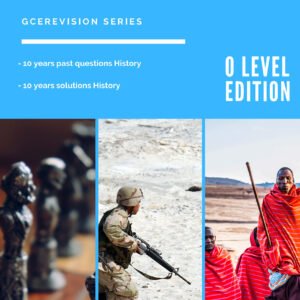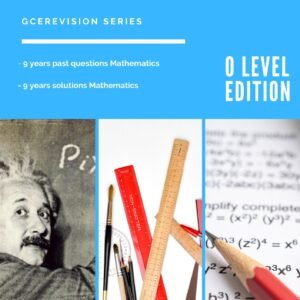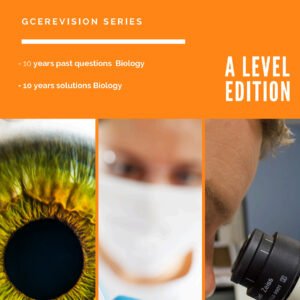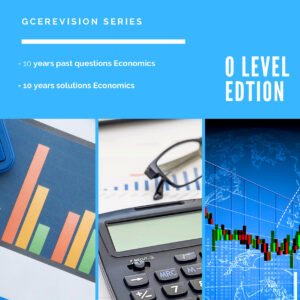advance level biology 2014 paper 2 answer guide
ADVANCED LEVEL BIOLOGY PAPER 2 MARKING GUIDE (2014)
1(a)
- tracheal system consists of tubes which are lined with chitin to give support; this ensures that they remain open during gaseous exchange;
- trachea branch internally into numerous intercellular tracheoles which are thin and permeable; this increases the rate of diffusion of gasses between the tracheoles and the body cells.
- The ends of the tracheoles are filled with fluid through which O2 and CO2 diffuse into and out of adjacent cells.
- Many insects have air sacs in their tracheal system; these air sacs function as bellows during vigorous body movements speeding up the movement of gasses to and from the tissues
- The large muscles located in the thorax and abdomen undergoes alternate contraction and relaxation leading to inspiration and expiration (1 x 6 = 6 marks)
(b)
- Breathing is controlled involuntarily by the respiratory center located in the medulla oblongata of the brain
- It has an inspiratory center which increases the rate and depth on inspiration and an expiratory centre which inhibits inspiration and stimulates expiration.
- The respiration center is linked to the intercostal muscle, diaphragm, bronchi and bronchioles by the intercostals nerves, phrenic nerves and vague nerves respectively.
- The main stimulus that controls breathing is the CO2 concentration in blood
- When the CO2 level in blood rises, chemoreceptors in the medulla, carotid and aorta are sensitized and they send impulses to the inspiratory center.
- The expiratory centre temporarily inhibits inspiration by causing the external intercostals muscles to relax and expiration takes place
- After expiration, the stretch receptors are no longer stimulated, and the expiratory center becomes inactive, inspiration can again begin (1 x 8 = 8)
(C)
- A natural unpolluted pond has oxygen in solution but the concentration of O2 in the water is very low (only 1% by volume)
- The temperature of the pond may rise because of solar radiations that heat the water body; this reduces the solubility of O2 in the water.
- The counter current flow system is used by this fish to maximize the absorption of oxygen from water.
- The water in which the fish lives is a denser and more viscous respiratory medium compared to air; this slows down the diffusion rate of gases.
- The possession of numerous gills (4 in each chamber) with numerous thin permeable gill filaments help to increase the surface are for gaseous exchange.
- The water that runs over the gills usually contains solid particles (food, mud etc.) which may reduce the permeability of the gill filaments
- Gill rakers are used to filter out the solid particles and prevent them from blocking the pores on the gill filaments (1 x 6 = 6 marks) (Total = 20 marks)
2(a) (i) D Q, = 1, 0
(ii) Adaptation of femur to its function:
- Hard compact bone provides mechanical support and prevents breakage
- Cylindrical in shape, resist bending
- Spongy epiphysial areas reduce weight for easy movements
- Round head for movement in all directions
- Cartilage reduces friction during movement
- Rough periosteum provides surface for muscle attachment
- The red marrow is responsible for RBC production, increases capacity of oxygen supply.
- Blood vessels supply nutrients and takes away wasted (1 x 5 = 5 marks)
(b)(i) Joints
- Points where two or more bones meet
- Types: unmovable e.g., sutures of the skull; slightly movable e.g. symphyses between vertebrate and freely movable/ synovial joint;
- Permit rotation of the head from side to side
- Enables bones to glid over each to a limited extent providing movement.
- Provides strength and support for the body; protects delicate structures which cannot withstand any kind of deformation
- Permit movement in all during flexion and extension e.g., hinge joint (1 x 6 = 6marks)
(ii) Tendons
- Attach muscles to bones
- Prevents muscle rapture when subjected to a heavy load.
- Ensures spatial/ fixed location of specific muscles to specify bones/ areas
- Concentrate the pull of muscle over a small area (1 x 2 = 2 marks)
(iii) Ligaments
- Connect bone to bone
- Strengthen joints
- Confine the movement of structures at each joint to a specific direction (1 x 2 = 2 marks)
(Total = 20 marks)
(3)(a)
- Is part of the PNS which controls involuntary activities in the body
- There are 2 division of the ANS namely; the sympathetic and parasympathetic nervous system.
- The sympathetic nervous system forms ganglia close to the spinal cord while the parasympathetic nervous system forms ganglia close to the effectors
- The effects of the two divisions are opposing (antagonistic) as shown below
| Sympathetic nervous system | Parasympathetic nervous system |
| It releases noradrenaline at the effector | It releases acetylcholine at the effector |
| It is active during stress and danger | It is active during rest, that is, it controls routine |
| It increases rate of heart beat | Decreases rate of heart beat |
(b) Steroid hormones
- They are deriving from cholesterol and are produces by endocrine glands of mesodermal origin
- They generally control long term responses of the body
- Examples; oestrogen, progesterone, testosterone, aldosterone, etc.
Mode of action of steroid hormones
- The hormone binds to a specific receptor in the cell membrane of the target cell forming a steroid- hormone receptor complex which diffuses into the nucleus and releases the hormone.
- The steroid hormone then activates a specific gene to produce mRNA by transcription.
- The mRNA passes out into the cytoplasm, and initiates the synthesis of the enzyme which brings out the desire effect.
(c) Visual acuity
- It is the precision or sharpness of the image we see.
- Visual acuity is greatest when the image falls on the fovea which contains only cones
- This is because in the fovea, one cone synapses with only one bipolar neuron and the bipolar neuron synapses with only one ganglion cell; this 1:1 relationship increases visual acuity.
Visual activity also increases as the number of cones in a particular area increases (1 x 4 = 4 marks)
(e) Trichromatic theory of colour vision
- Color vision is perceived by the three types of cones (light sensitive cells) in the retina (i.e., red, green and blue cones)
- Each type of cone processes a different type of iodopsin that absorbs light of different wave lengths.
- The trichromatic theory states that different colors are produced by the different degrees of stimulation of the three types of cones in the eye.
- Equal stimulation of the three cone types produces the color sensation of white, when only red and green cones are sensitized, we see orange etc.
- The back of any of these will lead to varying degrees of color blindness (1 x 5 = 5 marks)
(Total = 20 marks)
(4)(a)
- In the buccal cavity, saliva is secreted from the salivary glands into the mouth cavity.
- Saliva contains salts such as NaOH, NaHCO3, Ca2+ and K+ which provides the right pH for the action of enzyme,
- Mucus in saliva Contains lysozyme, a lytic enzyme which kills bacteria that might have come in with food
- Salivary amylase in saliva begins the hydrolysis of starch to maltose
- In the stomach, the parietal or oxyntic cells secrete dilute HCl while the chief zymogen cells secrete the inactive enzyme pepsinogen and prorenin from the stomach wall into the stomach.
- HCl renders the pH of the stomach contents acidic which is the pH ideal for optimum activity of stomach enzymes.
- It helps to kill any bacteria present in the food we might have come in from the mouth.
- It losses the fibrous and cellular components of food facilitating digestion.
- It activates pepsinogen to pepsin and prorenin to rennin.
- Pepsin breaks down proteins to smaller polypeptides
- Rennin coagulates the soluble milk protein caseinogen into insoluble casein which is then digested by pepsin.
- In the duodenum, bile is released from the gall bladder through eh bile duct and pancreatic juice is secreted into the duodenum from the pancreases.
- Bile is produced in the liver and temporarily stored in the gall bladder. It contains bile salts such as NaHCO3 which neutralizes acidic chyme from the stomach creating an optimum pH for pancreatic enzymes.
- Bile salt emulsify fats reducing their surface tension by breaking them into small droplets, increasing surface area for the action of lipase.
- Pancreatic juice contains pancreatic amylase which breaks down starch to maltose
- Pancreatic lipase which breaks down lipids to fatty acids and glycerol
- Trypsinogen activated to trypsin by the hormone enterokinase with hydrolyses proteins to smaller polypeptides
- Peptides which break down peptides to amino acids
- Nucleases which break down nucleic acids into nucleotides.
- In the ileum, Brunner glands in the intestinal wall secret fluids into numerous microscopic pits called crypts of Lieberkühn which then secret intestinal juice into the intestinal lumen which contains enzymes that complete the process of digestion.
- Maltase breaks down maltose to two glucose molecules
- Lactase breaks down lactose to juice and galactose
- Sucrase breaks down sucrose to glucose and fructose
- Nucleosidases break down nucleotides into pentose sugar, an organic and a phosphate group
- Peptidase breaks down peptides into amino acids
- Lipase breaks down lipids to fatty acids and glycerol
N/B: mouth = 3 marks, stomach 4 marks; duodenum = 4 marks; ileum = 4 marks (1 x 15 = 15)
(b)
- The flow of saliva is initiated by the sight, taste or thought of food, that is, by reflex action.
- The secretion of gastric juice is triggered by reflex action in which nerve impulses are released from the brain glands to secrete the hormone gastrin which stimulates the secretion of gastric juices.
- Partially digested food in the duodenum stimulates the release of enterogastrone from the duodenal lining which inhibits the secretion of gastric juice
- Acid chyme entering the duodenum stimulates the release of cholecystokinin from the intestinal wall which stimulates the release of bile from the gall bladder into the duodenum and secretion of pancreatic juice.
- Secreting is also secreted from the duodenal lining which stimulates the secretion of gastric juice rich in NaHCO3 (1 x 5 = 5 marks) (Total = 20 marks)
(5)(a)(i) Genetic Engineering is the manipulation of gene (DNA) to produce useful products
- It involves isolation, removal and cloning of useful genes (1 x 2 = 2 marks)
(ii) Biotechnology is the application of scientific and engineering principles to the production if materials by biological agents- Examples: fermentation of beer and wine (1 x 2 = 2 marks)
(b)(i) Production of insulin
Messenger RNA is extracted from human pancreatic tissue
The mRNA is treated with reverse transcriptase to manufacture copy DNA (cDNA).
The human regulator DNA is replaced by bacterial regulator DNA (marker gene) to ensure greater production endonuclease
A plasmid removed from bacterial cell is opened up at a specification point using the appropriate restriction nuclease
The cDNA is now attached to the plasmid using DNA ligase. The resultant plasmid carrying the human DNA for insulin is now called the plasmid vector.
The plasmid vector is reinserted into the plasmid free bacterial cell by using chemicals which make the wall permeable to the plasmid
The plasmid(s) replicate during fermentation of genetically engineering host bacteria.
This is followed by separation and purification of human insulin (1 x 8 = 8 marks)
(ii) production of cheese
- Milk is first pasteurized by destroying unwanted micro-organisms.
- Selected bacteria such as leuconostoc lactis which produces C02 and streptococcus lactis which produces lactic acid from milk sugar lactose are used
- Lactic acid coagulates the milk protein (casein) to form solid curd in a liquid component, the whey.
- Rennet is also added to clot the milk
- After removal of whey, salt is added to the curds to serve as osmotic preservative
- Preservation of the curd takes place for weeks and months in which in which enzyme driven changes take place that leads to the ripening and maturity of cheese. (1 x 8 = 8 marks)
(iii) manufacture of monoclonal antibodies
- An organism e.g., mouse is injected with antigen, e.g., red blood cells of a sheep.
- The antigens stimulate B-lymphocytes to produce anti-bodies.
- The B-lymphocytes produces plasma cell which are removed from the spleen of the mouse
- Tumor cells from the marrow of another mouse are collected-together with the plasma cells a hybridoma is gotten (tumor cells + plasma cells)
- The resulting cells are incubated in a special medium
- The hybridoma cells are then cloned on media in the laboratory
- This is followed by assaying for the best line of the hybridoma cells
- Large scale production is in an air-lift fermenter to prevent damage of the cells (1 x 8 = 8 marks)
(iv) commercial production of yoghurt
- Fresh milk is heat treated and later cooled to incubation temperature
- The fermenter is inoculated with a starter culture like Lactobacillus bulgaricus and Streptococcus thermophilus
- It is then incubated at 40 degrees Celsius for about 6 hours.
- bulgaricus breaks down milk protein into peptides
- The peptide is used by L. thermophilus to produce formic acid
- The formic acid is now used and lactose is broken down to lactic acid by L. bulgaricus
- There is coagulation of the milk by lactic acid
- Ethanol (acetaldehyde) is produced by each bacterial species giving the buttery taste.
(1 x 8 = 8 marks) (total = 20 marks)
(6)(a)(i) Xylem
- Made up of vessels and tracheid
- Consist of dead cells
- Allows unobstructed passage of water and mineral salts
- Has pits which permits horizontal transport
- Narrow lumen to improve capillarity
- Tapering ends overlap, giving additional mechanical strength
- Long and tubular vessels, good conducting structures
- Mark points annotated diagram
(ii) Parenchyma
- Made up of living cells involved in food storage
- Has a large sap vacuole, gives turgidity for support
- Irregular in shape as packing tissue
- Has thin cellular cell wall, pathway for water and mineral ions
- Elongated and flattened cell offer protection from desiccation and infection
- Plasmodesmata between adjacent cells, allow lateral transport between cells (1 x 5 = 5 marks)
(iii) Collenchyma
- Made up of living cells; covering outer region of cortex, midrib of leaves
- Elongated and polygonal cells
- Tapering end; give mechanical support
- Cell wall of cellulose; additional mechanical support (1 x 3 = 3 marks)
(iv) striated muscle
- Numerous muscle fibres; thin myofibers; long, cylindrical with alternate light and dark bands/actin and myosin contract and relax; voluntary movement.
- Oval nuclei at surface of each fibre; control cell activity
- Numerous mitochondria interposed between muscle filament; presence of glycogen; provide energy for muscular action
- Presence of vesicles triad involved in the uptake and release of Ca24 ions
- Fibres enclosed in sarcolemma; each has several motor neurons attached to its sheath; conduction of impulse; causes contraction of fibre
- Bundles of fibres enclosed by collagen fibres and connective tissues; from tendons at the ends of muscles attach muscles to skeletal elements (1 x 6 = 6 marks) (total = 20 marks)
(7)(a)(i)
| Mitosis | Meiosis |
| One mother cell gives two daughter cells | One mother cell gives four daughter cells |
| Each daughter cell diploid/ (2n) | Each daughter cell haploid/ (n) |
| Involves in asexual reproduction | Involved in sexual reproduction |
| No crossing over | Crossing over |
| Completed in one stage | Completed in 2 stages meiosis 1 and 2 |
| Occurs during the formation of somatic cells and some spores | Occur during formation of gametes or spores |
(ii)
- Halfling of genetic material in gamete
- Reconstitution in zygote during fertilization
- Maintenance of species characteristics
(a)(i) Placenta
- Link between mother and foetus
- Supply food to foetus
- Supply oxygen to foetus through umbilical vein
- Elimination of waste through umblical artery
- Defense of foetus, antibodies secretion
- Passive immunity
- Secretion of oestrogen and progesterone
(ii) Uterus
- Implantation, development
- Formation of corpus luteum
- Secretion of progesterone and oestrogen
- Contraction during birth
(iii) Pituitary gland
- Secretion of FSH, – Luteinizing hormone – Oxytocin
- Luteinizing hormone stimulates testosterone secretion
- Oestrogen, progesterone, ovulation
- Maintenance of corpus luteum
- Prolactin – milk production and secretion
(8)(a)
- Bipedal; opposable thumbs; larger brain; gestation usually long (40 weeks); longer period of parental care; highly developed communication system; almost hairless; exert control on the environment; found throughout the world
(b)(i) Homologous and characters
Homologous character’s structure which are fundamentally similar in form; having a common original; but serving different function at adult stage; e.g. force limbs of man and dog; while analogous characters are those with different origin; and structures but serve similar functions at adult stage; e.g, wings of birds and butter flies. (1 x 4 = 4 marks)
(ii) Convergent and divergent evolution
Convergent evolution: evolution in which complete organs or parts of organisms come to resembles each other; as a result of their sharing similar environments: and performing the same functions; e.g. the shark and a porpoise look alike, but a shark is a cartilaginous fish while a porpoise is a bony fish; while divergent evolution is evolution from a common ancestral line where numerous line of evolution arise; resulting in the basic pattern being modified to serve different functions; making descendants to fill a wide variety of niches; e.g. the forelimbs of a selection of vertebrates all come from a common pentadactyl pattern but are modified for various uses as in humans, cat, bat, birds, lizards, frog, whales (1 x 4 = 4 marks)
(c)
- The creation of new species is known as speciation and may result from natural selection, mutation or from Lamark’s theory of “Use and disuse”
In natural selection
- Organisms produce far more offspring that they can survive given the limited natural resources
- Individuals within a population vary
- These variation result from inherited characteristics
- Some of these variations may render the organism either more adapted or less adapter to its environment.
- Individuals with characteristics that make them more adapted to the environment survive the struggle for existence, grow and attain reproductive maturity and thus pass on their genes to their progeny
- Individuals that possess disadvantageous characteristics die before sexual maturity and therefore fail to pass on their genes to their progeny (1 x 6 marks)
Mutation
- Mutations result in random changes in the amount or chemical nature of DNA (genetic Material) in an organism
- Individual that carries advantageous mutations will be selected for whereas those with disadvantageous mutation will be selected again (1 x 2 = 2 marks)
According to Landmark
- Internal forces within organisms tend to be the determine factor of the extend to which the organs and the organisms grow
- Each organ is formed at least partly as a matter of feed or want
- Continual use of an organ leads to continuous development until development while lack of use leads to diminution until it completely disappears
- This theory was criticized based on the fact that changes which occurred in the organism in the course of life were not transmitted to the offspring (1 x 4 = 4 marks) (total = 20 marks)










